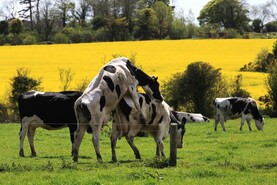At BEEF 2022 in Teagasc Grange on Tuesday 5 July there was a big focus on and indeed interest from attendees in dairy beef production systems.
Speaking to any farmer who rears calves through to beef, one of the first things they will say is how difficult it is to source good-quality calves.
The new Commercial Beef Value (CBV) will aid this significantly. Simply put, the CBV is a stripped-back terminal index that focuses on key traits such as carcase weight, conformation, feed intake and fat score. It takes the genetics of both the sire and the dam into consideration to give it its overall CBV.
Like the other indexes that farmers will be familiar with from ICBF, it ranks animals on a five-star basis. To do this they have broken stock into three categories – beef x beef cattle, dairy x beef cattle and dairy x dairy cattle.
Does it work?
The big question is does it work? Validation of the index was carried out on both the Teagasc Grange diary beef research herd and 10 other commercial diary beef farms across the country.
In the Grange diary beef herd, it was found that within the Holstein-Friesian stock (dairy x dairy), the five-star animals had a 33kg heavier carcase than one-star animals at a similar slaughter age.
For the beef-cross dairy cattle, the five-star animals had a 27kg heavier carcase weight at an average of five days younger slaughter age.
Interestingly, on the commercial farms, while the five star animals had a 29kg heavier carcase they were slaughtered 25 days later than the one star animals on average and scored one fat score lower (3= compared to 3+).
One problem that many dairy beef farmers have is that stock go over-fat at lighter weights. This result is showing that these five-star animals were older at slaughter but they were performing (+27kg carcase) during this period and it was worth feeding them on.
On average, they achieved a carcase weight of 339kg and graded an between an O+ and an R-.
Genomics
Obviously, like all indexes, it will only be as good as the information that is behind it. Currently that means we are reliant on farmers recording sires when registering calves. What will really improve this information and give farmers more confidence in the entire process is genomics. Ireland needs to get to a stage where every calf is genome-tested at birth.






 This is a subscriber-only article
This is a subscriber-only article











SHARING OPTIONS: